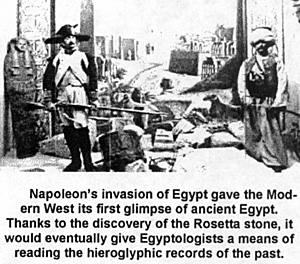 Having conquered Italy and driven Austria to the peace table, the young Napoleon Bonaparte wanted to be out
of the country, gathering fresh laurels, while the Directory finished doing what the practice of Rule-by-Committee has
always done--end in utter disaster. This would leave Napoleon untarnished by their blundering, and waiting in the
wings to march in and save France ... for himself.
Having conquered Italy and driven Austria to the peace table, the young Napoleon Bonaparte wanted to be out
of the country, gathering fresh laurels, while the Directory finished doing what the practice of Rule-by-Committee has
always done--end in utter disaster. This would leave Napoleon untarnished by their blundering, and waiting in the
wings to march in and save France ... for himself.
Napoleon's invasion of Egypt gave the Modern West its first glimpse of ancient Egypt. Thanks to the discovery of the Rosetta stone, it would eventually give Egyptologists a means of reading the hieroglyphic records of the past.
Napoleon went to Egypt under the guise of bringing civilization--as if Egypt had never had a civilization before--and for this he brought a considerable number of scientists and artists.
As a conqueror he brought about 36,000 troops on a fleet of a hundred ships. Napoleon took Malta from the Knights of Malta on his way to Egypt. Evading the English fleet under Nelson by chance--never an easy task by skillhe landed his troops near Alexandria July 1-3, 1789. He darted forward and seized Alexandria by storm with about 4,500 men. Following that, the French secured the coast, acquired numerous river craft, and proceeded up the Nile. The French Infantry in their woolen uniforms suffered cruelly from the heat, thirst, and disease--the pharaoh's revenge in the local waters, no doubt. While discontent spread through the ranks, Napoleon maintained firm control. Since he wasn't suffering, you could say that he was in denial.
The Mamelukes, a warrior elite who controlled Egypt, massed an army of about 40,000 men on the west bank of the Nile near Cairo. Some 6,000 of these troops were Mamelukes. They were some of the finest cavalry in the world. Most of the remainder of Murad Bey's army was that colorful oriental host of inept onlookers who are often found to fill out the ranks.
On July 21, 1798, Napoleon marched his army of about 25,000 men forward in a giant wheeling movement in a series of divisional squares, with artillery at the comers. The Mameluke cavalry charge repeatedly. There was only one recorded instance in the quarter of a century of the wars of Napoleon and the French Revolution in which cavalry charged and broke a formed square. This was not that time.
The Battle of the Pyramids had not been fought at the Pyramids, but for the folks back home it sounded more impressive than the battle of Embabeh. The real thrill came in looting the dead. The Mamelukes quite literally wore their wealth, and enterprising French soldiers bent their bayonets into giant fishhooks and dragged the Nile.
After the battle Napoleon sent General Desaix up the river after the retreating Murad Bey. Ibraharn Bey, who had watched the battle from the other side of the Nile, retreated toward Syria with the French in Pursuit.
On August 1, 1798 Nelson found the French fleet at anchor in Aboukir Bay, where they fought the Battle of the Nile for the same reason Napoleon had fought the Battle of the Pyramids. Having lost his entire fleet, Napoleon was trapped in Egypt, hopelessly outnumbered and unable to be reinforced. But Napoleon was in denial, so he forced an independent country under French leadership, invaded Syria (where the British and the Plague got in his way),
Finally, Napoleon returned to Egypt to deal with a Turkish invasion force at Aboukir. Mustapha Pasha landed with 18,000 men and dug in heavily. Napoleon attacked the Turks On August 2, 1799 with 7,700 men and threw the Turks into the sea. (Mind you, the Turks were in the Mediterranean Sea, so they cannot be said to have been in de Nile.)
On August 22, 1799 he and a select party returned to France on a fast French frigate, and the rest is history. Well, all of this was history too.
General Kleber remained in command in Egypt where he again defeated the Turks, but was assassinated. General Menou--an incompetent--then took command and lost Egypt to a combined British-Turkish invasion. The troops, however, by the terms of an earlier convention, were returned to France aboard English ships, where they were permitted to serve again. A similar fate awaited the garrison of Malta, which Vaubois surrendered in 1800 due to starvation.
Back to Novag's Gamer's Closet Summer 2002 Table of Contents
Back to Novag's Gamer's Closet List of Issues
Back to MagWeb Master Magazine List
© Copyright 2002 by Novag
This article appears in MagWeb.com (Magazine Web) on the Internet World Wide Web. Other articles from military history and related magazines are available at http://www.magweb.com